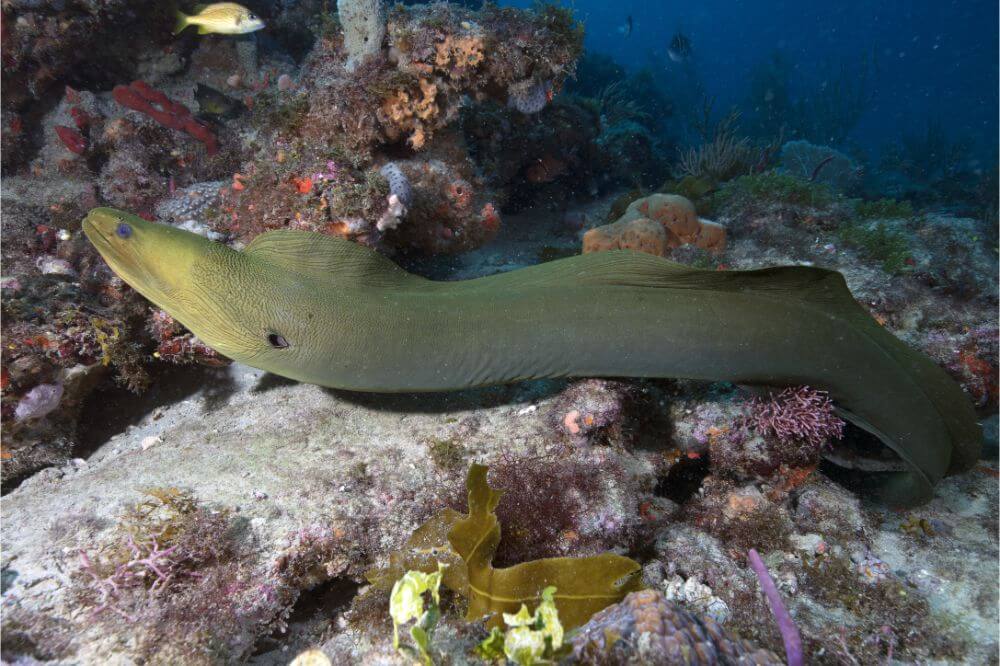The moray eel is another animal you may encounter when scuba diving.
This may look scary and intimidating, but they’re awesome when you see them up close.
This article discusses the information you need to dive safely around moray eels.
Contents
Moray Eels: The Basics
There are more than 200 species of moray eels.
Yes, that’s right, we said 200 species, not just 200 species of eels in general.
Almost all moray eels are marine animals living in saltwater.
However, a few are found in brackish water, and even fewer are found in freshwater.
One of the most interesting facts is that moray eels have two jaws.
They have a primary jaw with the largest set of teeth, and a pharyngeal jaw, a smaller jaw further back in the throat used to grab prey and pull it into its mouth.
Moray eels come in all sorts of colors and patterns, but they’re usually vividly marked.
Most types of moray eel won’t get longer than about 1.5 meters or 5 feet, but one species can be as long as 3.5 meters or 11.5 feet.
Moray eels look like a mix between a giant sea snake and a fish but are technically a type of fish.
Are Moray Eels Dangerous?
Generally speaking, moray eels aren’t found near the shore, so they aren’t much of a threat to people who are just swimming near the waterline.
Moreover, morays are nocturnal, so they really only come out at nighttime.
Many people think that moray eels and eels, in general, are aggressive animals that will attack anything that comes into sight.
However, this is not true. While morays are likely to attack people when they are disturbed, nothing should happen if you leave them alone.
On the other hand, if you are near a coral reef and you happen to sneak up on one that is resting in its hole, chances are that it will lash out and try to bite you.
However, moray eels really aren’t aggressive in nature, and they don’t attack us for the sake of it, but they will defend themselves, and they will do so with vicious strength.
Morays are known for having some of the strongest jaws, and their bites can take off fingers and even hands.
With that being said, throughout history, death by moray has only been recorded a few times.
In fact, it hasn’t really been recorded at all.
These are stories than anything else.
Generally speaking, you should be safe when scuba diving with morays because unless you stick your hand into its burrows or hiding spot, you should be fine.

Best Places to Scuba Dive with Moray Eels
The good thing is that if you want to scuba dive with moray eels, you can find them in nearly every ocean.
You can find morays in all subtropical and tropical areas of the world.
They usually live in relatively shallow water among coral reefs and rocks.
They like to hide, and they like their privacy, so they’re usually found inside crevices.
That said, if you want to see giant moray eels travel to the Indo-Pacific region.
You can find them off the east coast of Africa, the Red Sea, around the Hawaiian Island, Polynesian, Japan, Fiji, and the Austral Islands.
Best Time of Year to See Moray Eels
When it comes to seeing moray eels while scuba diving, the time of year is not that relevant.
However, moray eels are nocturnal, so go night diving for the best chance to see them.
Tips for Diving with Moray Eels
The only relevant tip when it comes to diving with moray eels is that you probably shouldn’t stick your fingers in their faces, and moreover, don’t stick your hands in holes and crevices in coral reefs and rocks.
Otherwise, you’re unlikely to have your finger bitten by a moray eel you have just scared.
Wrapping Up
While moray eels may seem scary, they’re actually pretty peaceful and but very frightful; they do not like humans being around them.
So, although they are fantastic creatures to see up close, the chances of seeing one are not that high.





